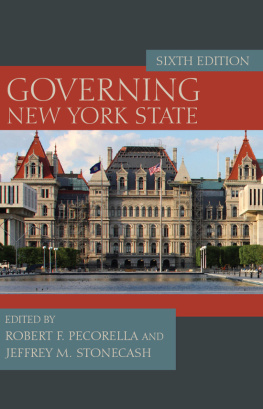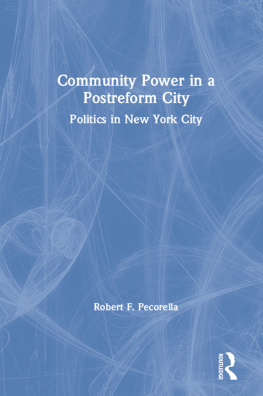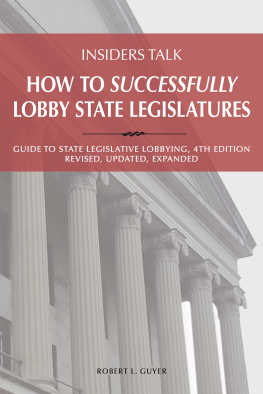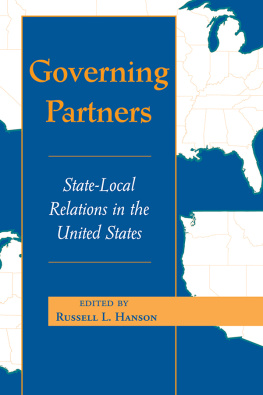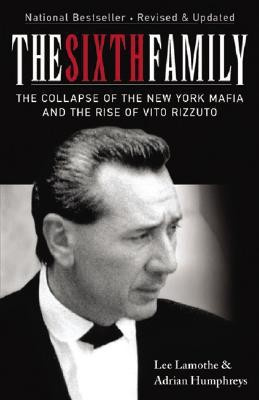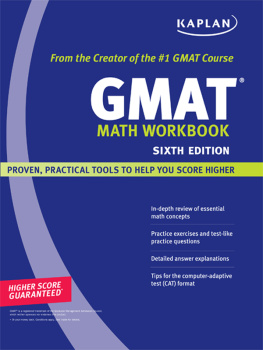Published by State University of New York Press, Albany
2012 State University of New York
All rights reserved
Printed in the United States of America
No part of this book may be used or reproduced in any manner whatsoever without written permission. No part of this book may be stored in a retrieval system or transmitted in any form or by any means including electronic, electrostatic, magnetic tape, mechanical, photocopying, recording, or otherwise without the prior permission in writing of the publisher.
For information, contact State University of New York Press, Albany, NY www.sunypress.edu
Production by Eileen Nizer
Marketing by Michael Campochiaro
Library of Congress Cataloging-in-Publication Data
Governing New York State / edited by Robert F. Pecorella and Jeffrey M. Stonecash. 6th ed.
p. cm.
Includes bibliographical references and index.
ISBN 978-1-4384-4473-4 (hardcover : alk. paper)
ISBN 978-1-4384-4472-7 (pbk. : alk. paper)
1. New York (State)Politics and government1951 2. New York (State)Economic policy. 3. New York (State)Social policy. I. Pecorella, Robert F., 1948 II. Stonecash, Jeffrey M.
JK3416.N48 2012
320.9747dc23
2012001543
10 9 8 7 6 5 4 3 2 1
Regional Political Conflict in New York State
ROBERT F. PECORELLA
Political conflict over regional concerns in New York is as old as the state's history and as current as today's news stories from Albany. Grounded in different needs and interests, these regional concerns both reinforce and reflect larger ideological distinctions between and among the state's political parties. Although the ideological divide in New York is less pronounced than it is nationally, the liberal wing of the Democratic Party, represented by a number of state legislators from New York City and upstate urban districts, and the conservative wing of the Republican Party, represented by legislators from upstate rural areas and suburban districts, each reflect distinctly different approaches to governance.
In recent years, these differences have been exacerbated among conservatives in New York by the tea party notions permeating the national Republican Party evident in the angry tone of Carl Paladino's 2010 gubernatorial campaign. They have been reinforced on the left by proposals to downsize public employee pension benefits and cut social service programs in the wake of the recent economic downturn. Divided governance, the norm in New York for four decades now, and interrupted only briefly by the somewhat chaotic one-party governance of 20092010, serves to make these regionally based, ideological positions highly relevant to policy decision making in Albany.
Politics concerns choices about who gets what share of scarce resources and from this perspective one region's gain is often perceived as another's loss. Political conflicts in New York, therefore, often emerge from the socioeconomic differences between and among the different regions in the state. This chapter, which examines the nature of regional political conflicts in New York and their impact on state governance, is divided into three sections. The first section reviews the historical evolution of regional politics in New York State from an era best characterized as an upstatedownstate dichotomy to one of a tripartite regional division defined by the suburbanization of the state's population. Section II examines a number of the current demographic, socioeconomic, and political differences between, among, and within the various regions in the state. And the third section analyzes how these regional differences are both manifested and somewhat blurred in today's legislative and executive politics and policymaking in Albany.
A History of Regional Conflict in New York
From the early nineteenth to the middle of the twentieth century, regional politics in New York reflected largely an upstatedownstate division between New York City and the rest of the state. In part, this division had an inherent cultural dimension. People from cities and people from more rural areas often view each other with emotions ranging from bemusement to hostility. As creations of modernity, cities challenge the traditional culture found in rural areas by incubating liberal social and political attitudes and as the country's most modern and most international city, New York has always represented the greatest American challenge to traditional values.
But cultural differences explain only part of the upstatedownstate divide of this period. Regional tensions also were based in the state's socioeconomic development and political history. The opening of the Erie Canal in 1825, linking New York City to the American heartland, secured the city's position as the premier commercial center in the United States. Although parts of upstate New York, most notably the cities of Buffalo and Rochester, as well as other cities and towns that grew along the route of the Erie Canal, also developed as commercial and cultural centers, the upstate economy remained largely agricultural and its residents, particularly those in more rural areas of upstate, were not as cosmopolitan in social custom or economic outlook as those in New York City.
New York City's emergence as the country's primary commercial center in the early nineteenth century initiated a process of downstate urban development that has seen the city remade several times as periodic economic crises created the demand for governance changes that then helped lay the foundations for eventual economic restructuring. This process of crisis, retrenchment, and recovery saw commercial New York City become the politically consolidated, industrial giant of the late nineteenth mid-twentieth centuries and then, painfully in the 1970s, begin the evolution toward becoming the postindustrial, financial center of American capitalism in the twenty-first century. This economic evolution also encouraged one of the most notable characteristics of the New York City experiencea dramatic and continual process of foreign immigration that first changed the city's ethnic and religious make-up, then reformulated its racial demographics, and eventually resulted in the creation of today's global city. In terms of regional divisions, the immigration resulting from economic changes served to reinforce already existing cultural differences between New York City and the rest of the state.



